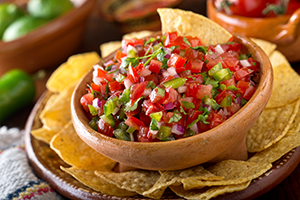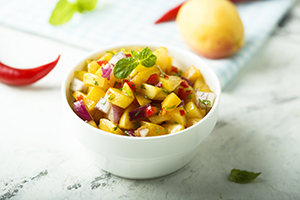This low-calorie condiment is very easy to make and can be used instead of high calorie salad dressings or as a topping for eggs, meats, burgers, sandwiches, and as a mix-in for soups, stews, pasta dishes, casseroles and grits.
When fresh ingredients are used, salsa is full of vitamins and nutrients including vitamin C, fiber, antioxidants and capsaicin that boosts metabolism and lowers blood sugar.
Try these two basic recipes and experiment with different ingredients!

 Basic Salsa
Basic Salsa
3 Roma tomatoes, chopped
1 jalapeno pepper, seeded and minced (more for spicier salsa)
1/2 cup white or red onion, diced
1 clove of garlic, minced
¼ cup packed fresh cilantro leaves, chopped
1 large lime, juiced (about ¼ cup lime juice)
Salt to taste
In a serving bowl, combine the tomatoes, peppers, onion, garlic and cilantro. Drizzle with lime juice and mix well. Season to taste with salt. Let rest for 10 minutes or longer to enhance the flavor.
Optional ingredients for basic salsa:
Avocado
Bell peppers
Black beans
Corn kernels
Jicama
Radishes

 Fruit Salsa
Fruit Salsa
3 cups of diced fruit (mangoes, peaches, pineapple, strawberries, or a combination of fruits)
1 medium red bell pepper, chopped
½ cup red onion, chopped
¼ cup packed fresh cilantro leaves, chopped
1 jalapeño, seeded and minced (more for spicier salsa)
1 large lime, juiced (about ¼ cup lime juice)
Salt to taste
In a serving bowl, combine the prepared fruit, bell pepper, onion, cilantro and jalapeño. Drizzle with lime juice and mix well. Season to taste with salt. Let rest for 10 minutes or longer to enhance the flavor.